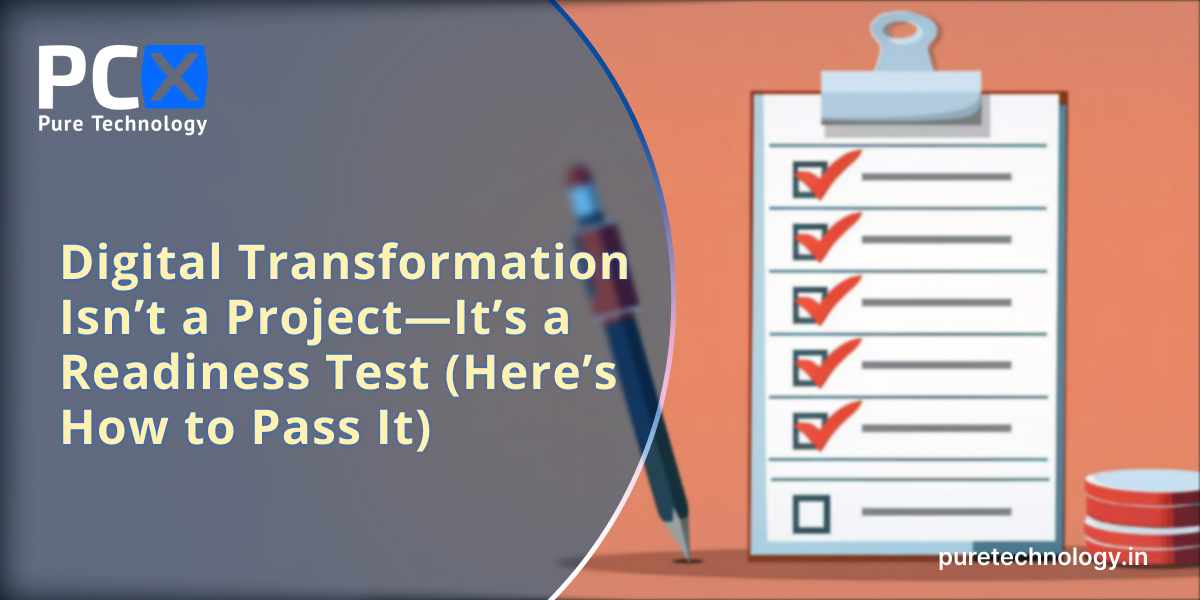Digital Transformation Isn’t a Project—It’s a Readiness Test
In today’s digital era, almost every organization talks about transformation—but only a few are genuinely prepared for it.
Too often, businesses confuse transformation with basic IT upgrades—like cloud migration, app redesign, or process automation. While these may play a role, true digital transformation isn’t something you can buy, install, or outsource. It’s a strategic and cultural shift that demands alignment across people, processes, and technology.
If your company isn’t ready, the result is wasted budgets, delayed timelines, and outdated solutions that customers won’t embrace.
This readiness guide will show you how to evaluate, prepare, and pass the digital transformation test.
1. Transformation Isn’t Just a Tech Upgrade
The traditional playbook—moving to the cloud, launching an app, or automating workflows—is outdated. Customers today expect fast, intelligent, and personalized experiences.
That requires more than digital tools. It demands smart, adaptive products powered by AI and automation. And it’s not just IT’s job—every department (product, sales, operations, marketing, and customer service) must align to deliver continuous value.
👉 True transformation means AI-driven products built for agility from day one.
2. Diagnose Before You Transform
Before you start building, you must ask: “Where are we right now?”
Companies often jump into innovation without auditing their systems, infrastructure, or team capabilities—like remodeling a house without checking the foundation.
A transformation audit should cover:
- Code quality and architecture stability
- Application performance and scalability
- Cloud infrastructure readiness
- DevOps pipelines (CI/CD)
- User experience alignment
- QA and defect rates
Without this clarity, transformation will fail before it starts.
3. Define Outcomes, Not Just Tools
The worst way to start? By chasing technologies—AI, microservices, or blockchain—without linking them to business goals.
Instead, ask:
- What does success look like in 6 to 12 months?
- Is the goal faster releases, reduced churn, or higher revenue?
Digital transformation must begin with clear business outcomes mapped into a technical roadmap. That ensures you know what to build, in what order, and why it matters.
4. Capacity Over Headcount: Build the Right Team
Adding more engineers won’t guarantee success. Transformation requires cross-functional teams with the right skill mix—UX, QA, DevOps, product strategy, and data science.
Many in-house teams are built for maintenance, not innovation. That’s why companies often rely on dedicated teams or guided staff augmentation to accelerate delivery with the right expertise from day one.
5. Launch Fast, Improve Continuously
Perfection slows progress. Transformation succeeds through rapid iterations, not long, rigid plans.
The approach?
- Release MVPs quickly
- Collect real user data
- Improve every sprint
- Introduce AI and automation once the foundation is stable
Small, consistent wins create measurable impact—and momentum.
6. Embrace Change: Agility Beats Rigid Plans
No roadmap survives unchanged. Priorities shift, markets evolve, and teams adapt. That’s not failure—it’s part of the process.
Agile transformation frameworks focus on:
- Flexible planning models
- Fast feedback loops
- Continuous adaptation
The goal isn’t a flawless plan—it’s building a system that thrives in uncertainty.
7. Transformation Is Ongoing, Not a Destination
Digital transformation doesn’t “end.” It evolves.
Once your systems are flexible and teams aligned, you no longer need massive overhauls every few years—you continuously innovate.
With AI, you can:
- Build products that learn and adapt
- Automate workflows in real time
- Predict trends before competitors
- Empower teams with smarter tools
👉 This is AI-driven transformation—the next level of digital readiness.
Final Takeaway: Are You Ready?
You don’t need the biggest budget or the perfect plan. You need the readiness to take the right steps in the right order.
- Start with a brutal truth audit
- Define clear outcomes
- Build the right capacity
- Deliver small, measurable wins
- Stay flexible and continuously evolve
🚀 The first step is a Product & Technology Audit—a readiness check that shows what’s working, what’s broken, and what to prioritize next.
Because in the end, digital transformation isn’t a project—it’s your company’s readiness test.
Call us for a professional consultation












Leave a Reply